Located in Perthshire, Scotland on the shores of Loch Tay, the ‘haunted’ old village of Lawers dates back to mediaeval times. Once the most important village in the area and home to the Lady of Lawers, it now lies in ruins, providing a rare glimpse back in time.
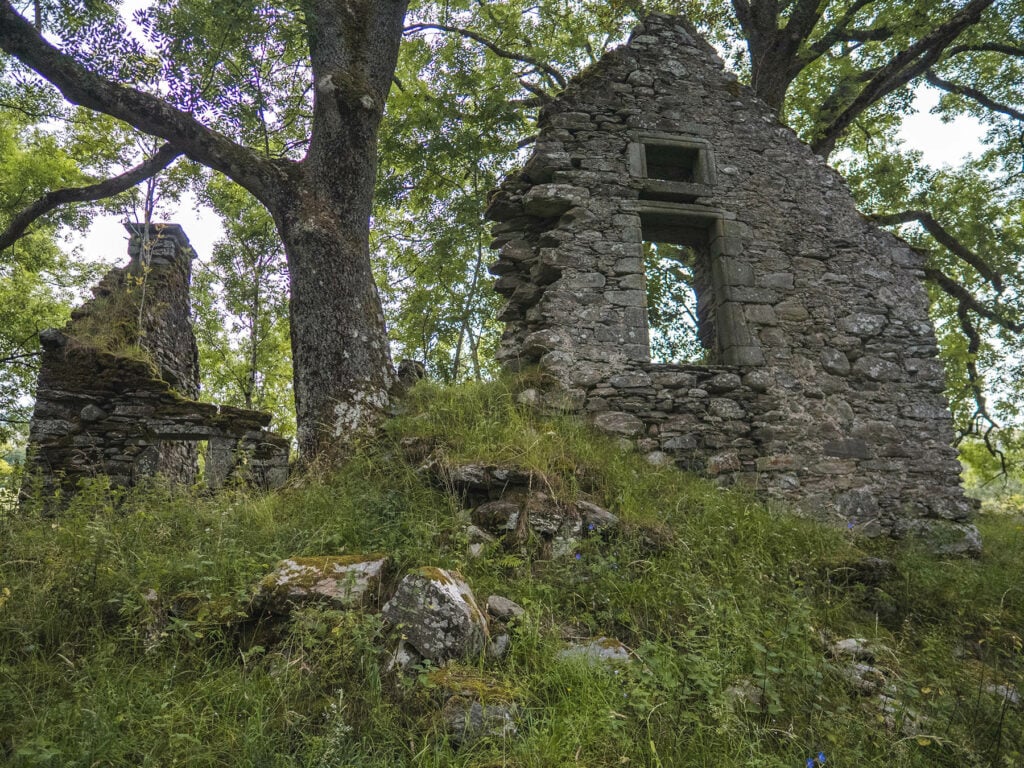
The abandoned village of Lawers is located at the foot of Ben Lawers, the highest mountain in the Breadalbane region of the Scottish Highlands.
The old village is just a 30 minute walk down the hillside from the (new) Village of Lawers and one of the most fascinating places to explore around Loch Tay.
Featuring its own ghost, the untouched ancient settlement of Lawyers is a real hidden gem and hard to find unless you know where you’re going.
The settlement consists of several substantial 17th century stone buildings, the remains of further buildings including houses and two mills, a burial ground and a pier.
In this guide I’m going to tell you everything you need to know to visit this magical place and have you avoid the mistakes I made trying to locate the village.
Old Village of Lawers Map
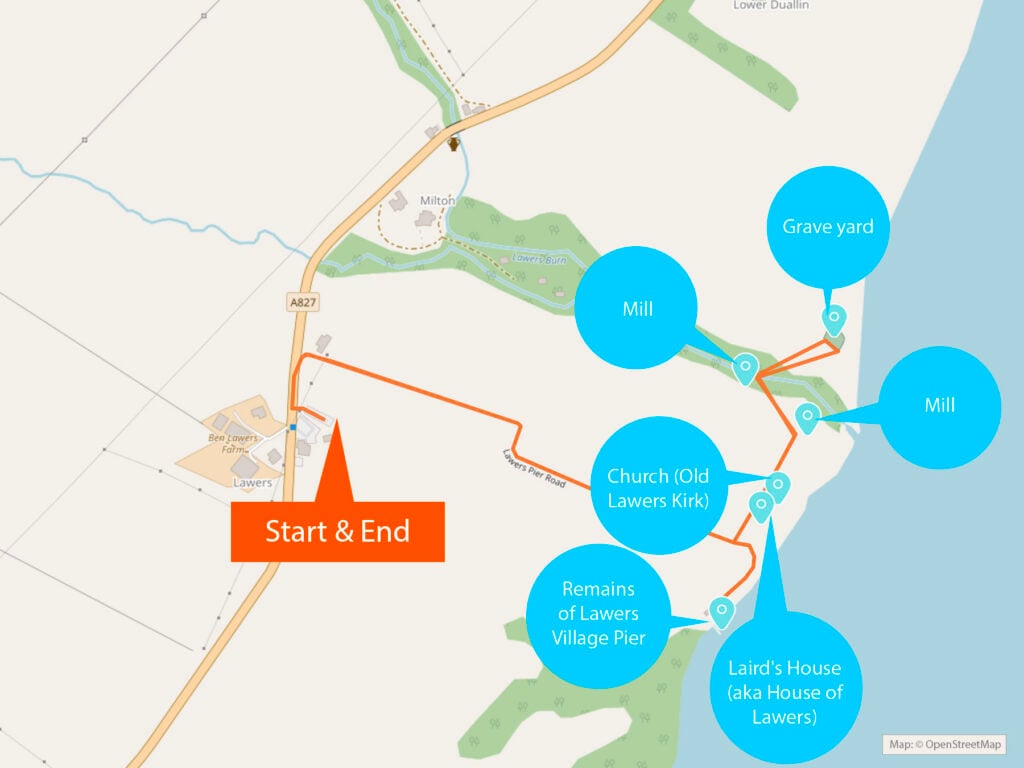
Just here for the walk? Jump to the walks section to see detailed guides on my favourite Dovedale Stepping Stones walks including maps, photos, step-by-step directions and GPX files.
The Old Village of Lawers Quick Facts
Walk difficulty: Easy
Shortest walk length (return): 1 hour
Accessibility: Path unsuitable for wheelchairs
Operated by: Privately owned but open to public
Dog-friendly: Yes
Child-friendly: Yes (with close supervision)
Best time of year to visit: Spring or summer. Avoid periods of heavy rain when the village may be muddy and more hazardous.
Best time of day to visit: Anytime during daylight
Entry costs: Free
Car park costs: £5 (all day)
Opening times: 24/7
Food: 3 minutes walk from walk from carpark at Ben Lawers Hotel
Top Tip: Carefully study our map and walk guide beforehand as it can be hard to find
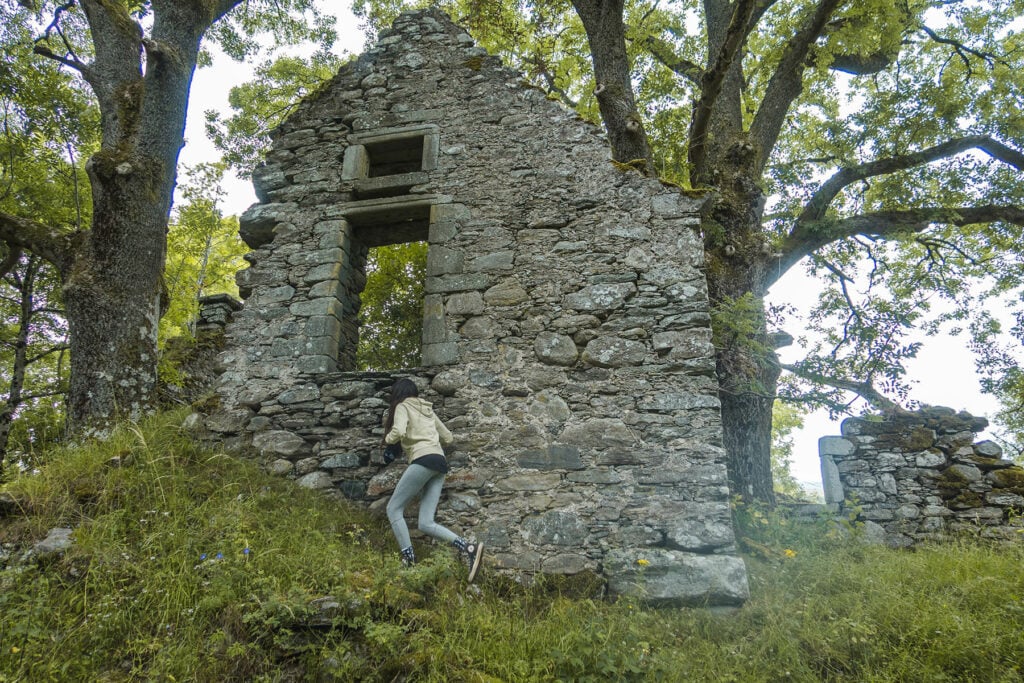
Table of Contents
- The Old Village of Lawers Quick Facts
- What is the The Old Village of Lawers?
- Abandoned Villages in Scotland
- Is The Old Village of Lawers Haunted?
- Who Owns The Old Village of Lawers
- A History of this Abandoned Village in Scotland
- Planning your Visit to the Old Village of Lawers
- The Old Village of Lawers Walk
- Where to Stay Near The Old Village of Lawers
- Final Thoughts on The Old Village of Lawers
What is the The Old Village of Lawers?
The Old village of Lawers is an abandoned ruined village encroached by trees at the side of Loch Tay. The village is all that remains of a community which has existed for over a thousand years and formed an important focal point of the Loch Tay community.
At both the northern and southern ends of the site, there are Scheduled Ancient Monuments. Additionally, some portions of the site have been categorised as a Special Area of Conservation (SAC).
The village is gradually becoming more ruined as nature takes back control and the highland weather beats down on the remains. In the meantime Lawers offers a rare glimpse into a once unique way of life of the people who inhabited the highlands of scotland.
The inhabitants etched out an often meagre living through farming and fishing and finally flax milling until around 1962.
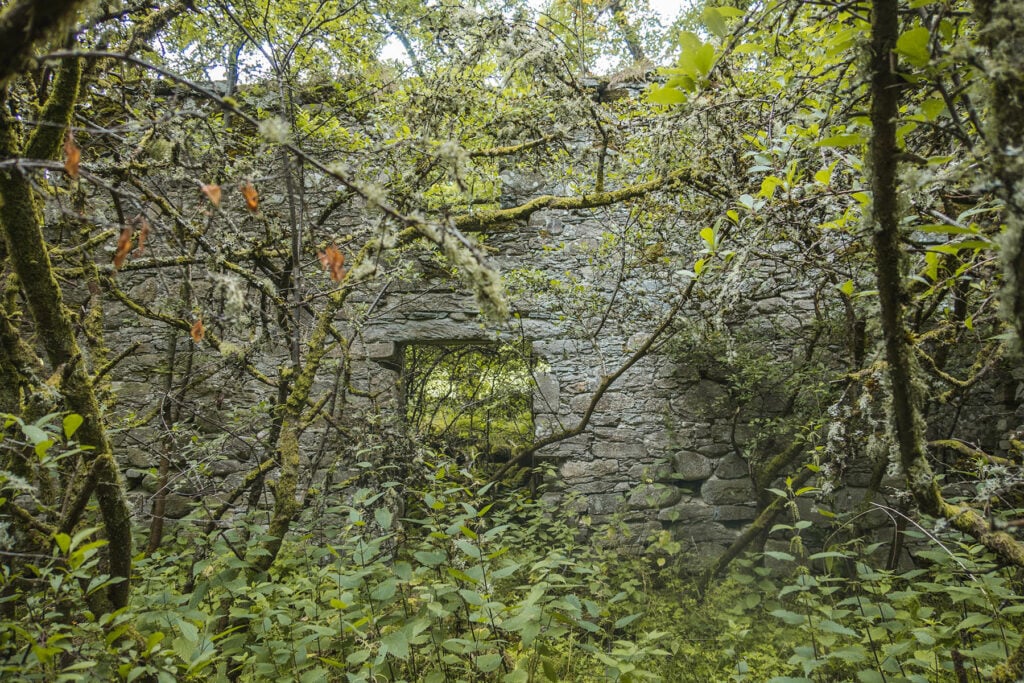
The village comprises the remains of Lawers pier and Pier House (Ferry Masters house) which was home to the last inhabitants of the village who left in 1926.
The Laird’s House (House of Lawers) which is believed to have been built on the site of Lawers Castle. The house incorporated two of the former castle walls and was home to the mysterious Lady of Lawers.
Next to Lairds house sits the remains of the church (Old Lawers Kirk) is an impressive sight with an ash tree growing in the centre. The Church used to attract worshipers from surrounding villages who would travel over to Lawers by barge.
To the east is the second part of the village with more dwellings and a mill. There is a bridge over Lawyers Burn (large stream) which takes you to the remains of the Flax Mill, Church and the Churchyard.
The name Lawers originates from its Gaelic equivalent, “the noisy one.” This name is attributed to the burn, which is a large stream, that cascades down the hillside from Ben Lawers into Loch Tay.
Folk-law
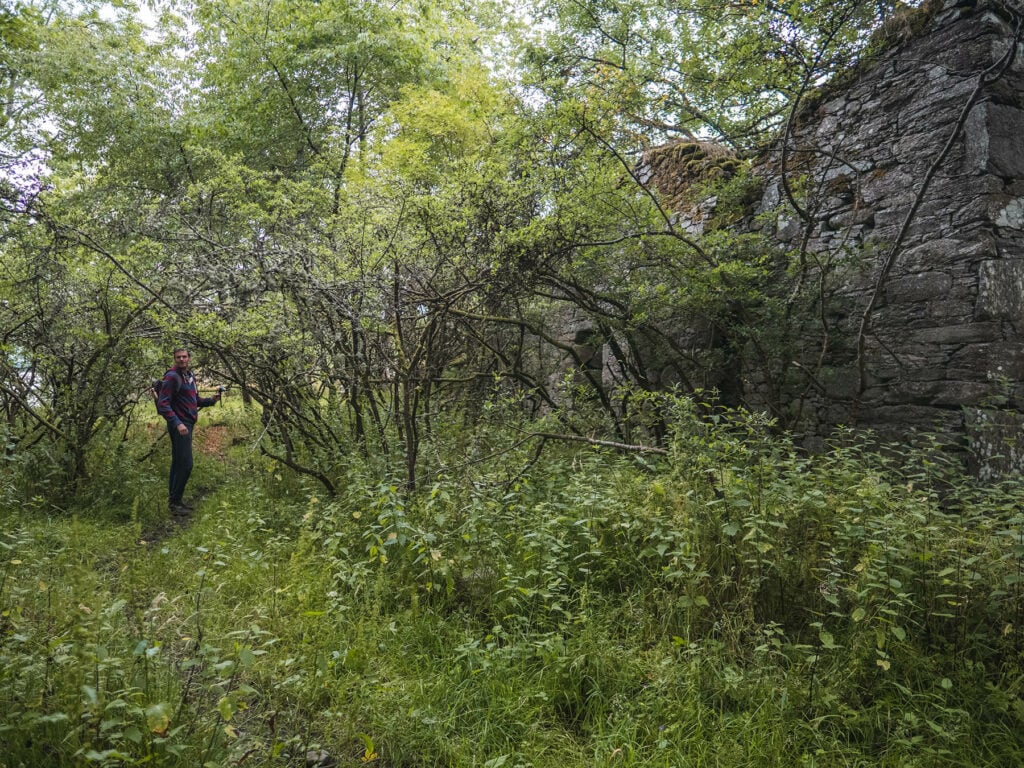
Abandoned Villages in Scotland
There are a number of abandoned villages in Scotland. Many of these are documented on the Abandoned Communities website.
A great number of the abandoned villages in Scotland were the result of the controversial Highland clearances which took place in two phases from 1750 to 1860. Landowners cleared the villagers away to make room for sheep farming which was more profitable for them. In some cases they would throw villagers out of their houses and then burn the thatch roofs so they couldn’t return. In some cases houses were set alight with villagers still inside.
The old village of Lawers is possibly one of the best examples of an abandoned mediaeval village in Scotland as many of the ruins are in relatively good condition as you’ll see from my photographs.
Other abandoned villages in Scotland include: The Village at Binnend which was built to serve the Shale Oil works. The lack of basic facilities led to the formal closure of the village about 1931 with the last villager departing in 1954.
The Village in St Kilda contains a large abandoned village with houses dating back to 1830’s and burial structures dating from the Bronze Age. St Kilda is The UK’s only dual UNESCO World Heritage Site and is situated off the West Coast of Scotland in Outer Hebrides of Scotland.
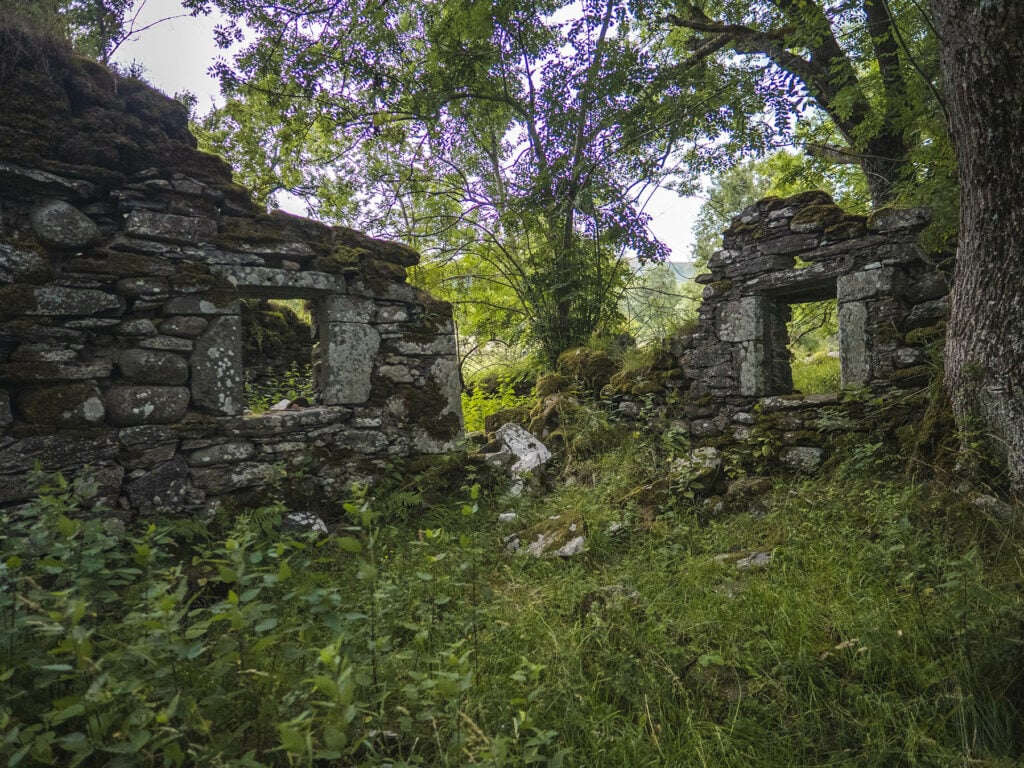
Is The Old Village of Lawers Haunted?
The abandoned village of Lawers is said to be haunted by a 17th Century seer known as the Lady Of Lawers who made many predictions about the area which later came true.
A Seer is a woman gifted with the power of wisdom and second sight.
During my visit to the village, as I ducked under the bushes which have grown around the Lady Of Lawers former house, I sensed something strange and a shiver ran down my spine.
It’s reported that visitors to the village at night have reported supernatural occurrences.
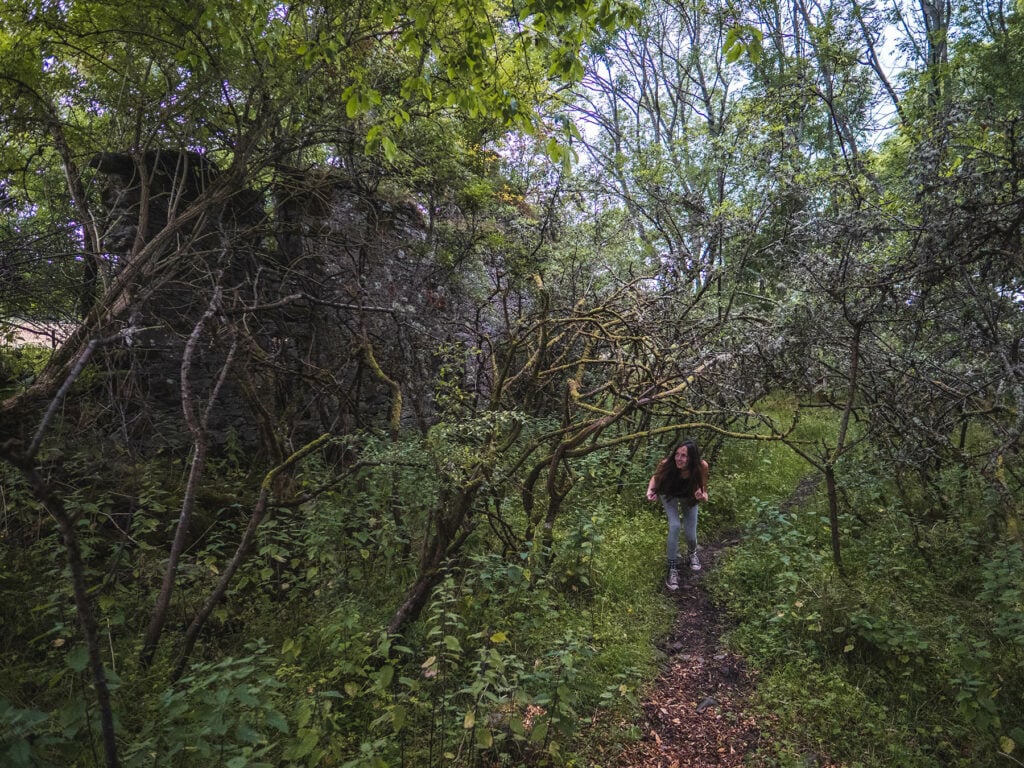
Lady of Lawers
There are no written records left to confirm the identity of the lady of Lawers. However, evidence suggested that her name was Mary Campbell. She was originally a Stuart of Appin in Argyll and was brought to Loch Tay to marry the younger brother of Sir James Cambell, the 4th Laird of Lawers around 1640.
The lady of lawyers is believed to have arrived with a customary escort containing some of the biggest and heaviest men in Scotland who took up residence in her house as bodyguards.
It is thought that her body guards might have signalled her importance and perhaps were also necessary due to the fact that women perceived as witches were in danger due to the scottish witch hunts at that time.
It was only much later in her life that she was able to feely make predictions without fear of retribution.
It is thought that her family were responsible for much of the production of the old village.
In her final years the Lady of Lawers made many predictions such as accurately predicting steam ships and “fire coaches” 200 years before the advent of railways.
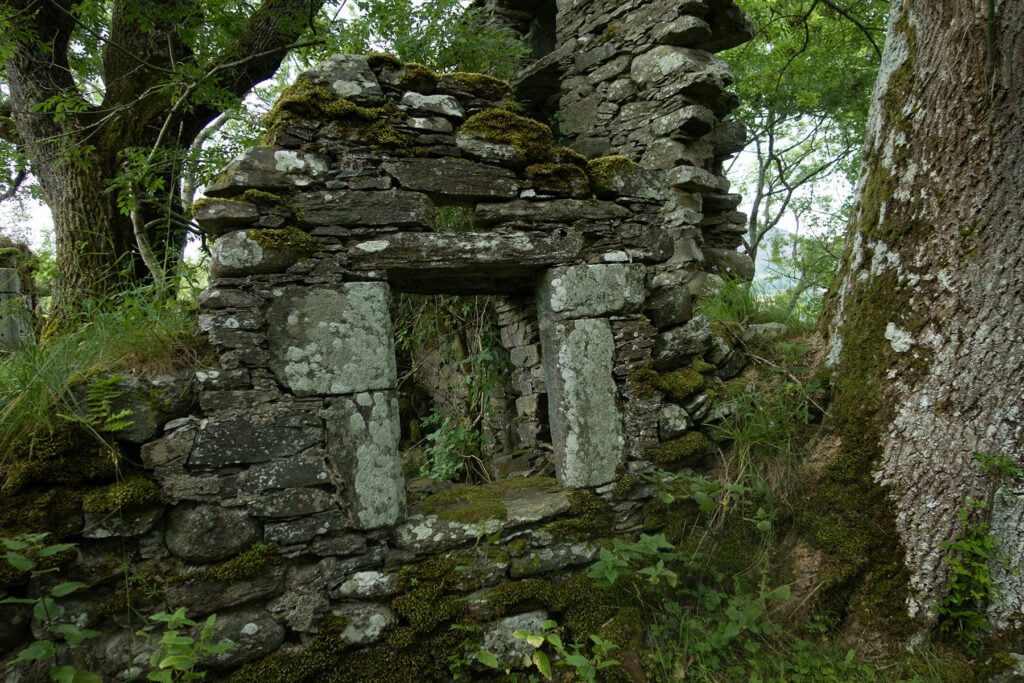
After the church was built the Lady planted an ash tree besides it’s north side and prophesied:
The tree will grow and when it reaches the gable the church will be rent in twain (split in two).
When it reaches the ridge, the House of Balloch will be without an heir.
Lady of Lawers
Rather ominously the Lady also went on to say:
A sudden accident will befall the man who cuts the tree.
Lady of Lawers
In 1843 when the tree reached the height of the gable, a thunderstorm destroyed the west loft of the church rendering it derelict and thus the first part of the prophecy was realised.
As the tree finally reached the roof ridge in 1862, John Campbell the 2nd Marquess of Breadalbane of the House of Balloch died with no heir, rendering the House of Balloch extinct and thus the second part of the prophecy became true.
Finally, in 1875, a local farmer from the Milton of Lawers farm went into the Village Of Lawers to cut down the tree. Local villages warned him against it but he wouldn’t listen to them.
Using an axe he felled the Lady’s Ash Tree and his horse hauled the tree away.
A week later he was gored by his own highland bull and died from Gangrene as a result. The next day his horse inexplicably dropped dead. Terrified by the chilling execution of the curse, his assistant grew insane and had to be dragged to the local asylum.
The curse didn’t stop there. As the dead farmer’s body was carried on a boat to the other side of Loch Tay, the normally calm water erupted into a storm and engulfed the boat. Everyone on the boat believed they would drown. However, they eventually made it to the other side. The moment they docked the loch became eerily calm again.
The Lady of Lawers accurate prophecies such as the above were the talk of Loch Tay and written records were kept in the Red Book of Balloch.
You can learn more about the lady of Lawers and see some historic footage of the village by watching Weir’s Way – The Lady of Lawers Part 1 and Part 2 on Youtube.

Who Owns The Old Village of Lawers
Lawers was purchased by a private buyer in 2016 who unsuccessfully applied for planning permission to build a house on the site.
The Old Village of Lawers went up for sale again in 2021 for £125,000. According to the selling agent there was a lot of interest from both locals as well as Americans and Europeans.
According to the Old Lawers Website, the village was acquired by the Donnelly Family who are members of the Breadalbane Community.
According to the website, their present aim is to simply preserve the area during their period of custodianship.
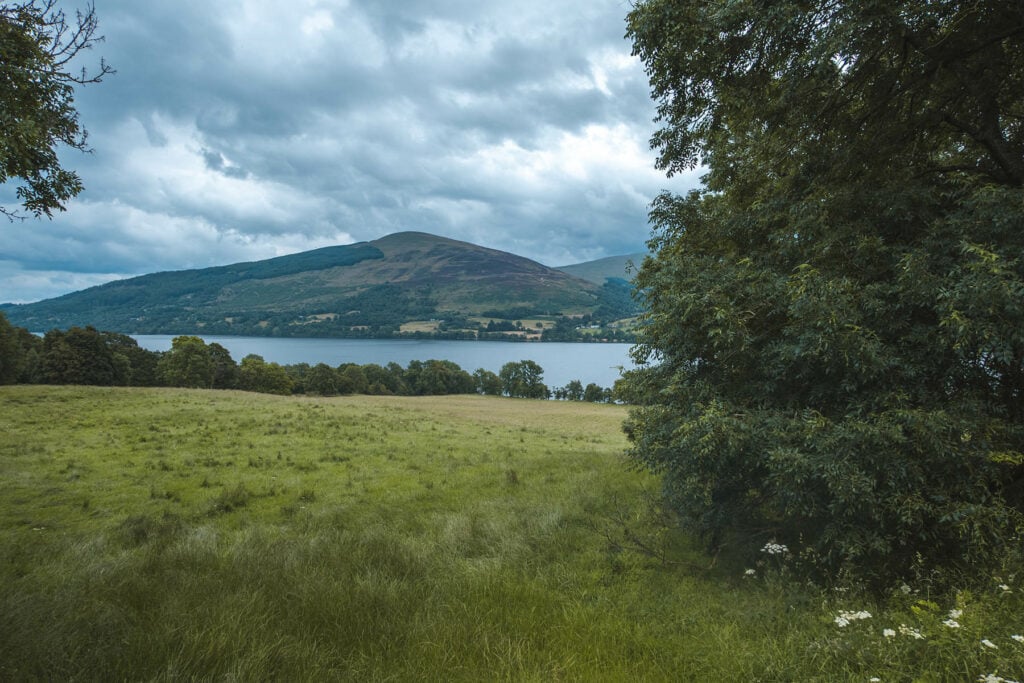
A History of this Abandoned Village in Scotland
This once vibrant ancient settlement has witnessed many significant events in Perthshire throughout its history.
We know the village was occupied from the mediaeval times (1160) and possibly much earlier all the way through to the early 20th Century.
During much of its history the village was an important part of the once much larger Loch tayside population.
The remains of the pier in the Old Village of Lawers are a reminder that the village was once an important terminal for barges and later ferries, which would transport people and livestock across Loch Tay. The Pier was first referred to as Milton pier and later Lawers Pier.
On a Sunday morning half of the congregation of Loch Tay would arrive by boat. The first Church was the Chapel of Machuim later which was burned to the ground. Using the same stones the new Church of Lawers was built in 1669.
The Church has an enclosed graveyard known as Cladh Machuim which is still in use today. As a Commonwealth War Graveyard, it’s the best maintained part of Lawers. The name Machuim no doubt comes from the nearby farm of the same name.
Below is a quick chronological summary of the key historic events of the village
MacMillans of Argyllshire are Bestowed the Barony in 1160
In 1160, King Malcolm IV of Scotland bestowed the barony of Lawers upon the MacMillans of Argyllshire, marking one of the earliest known references to Lawers.
A barony is a type of feudal land tenure that was granted by the king or queen of a country to a nobleman or noblewoman. The Baron or baroness was granted certain privileges and rights to the land they held. It was often associated with a castle or fortress that served as the seat of the baron or baroness.
Thomas Chalmers Takes Lawers by Force in the mid 1400s
Thomas Chalmers obtained the land which included Lawers by force from the MacMillans clan in the mid 14th century in the reign of David II.
The Chalmers had previously been involved in the murder of James I and this later came back to bite them (more on this below).
The Cambell’s is Bestowed Ownership of Lawers in 1473 and Builds a Tower Castle
In 1473 Sir Colin Campbell played a role in capturing those responsible for the murder of King James III’s grandfather (King James I). Those captured included Thomas Chalmers, the owner of Lawers.
King James III was delighted by the vengeance of his grandfather’s murder and as a reward he granted the Barony of Lawers to Sir Colin Campbell.
Soon after the Campbells built a small castle aka tower house in the village of Lawers on the banks of Loch Tay. The Castle of Lawers was a manor house estate of great importance locally and granted a crown charter allowing legal documents to be served there.
The village was passed down through six generations of Cambells. During this time James Graham the 1st Duke of Montrose burnt down the castle and the original Lawers Chapel in 1645 during the War of the Three Kingdoms. He was later tried and executed.
It is believed that the remains of the tower castle formed part of what is now Lawers House.
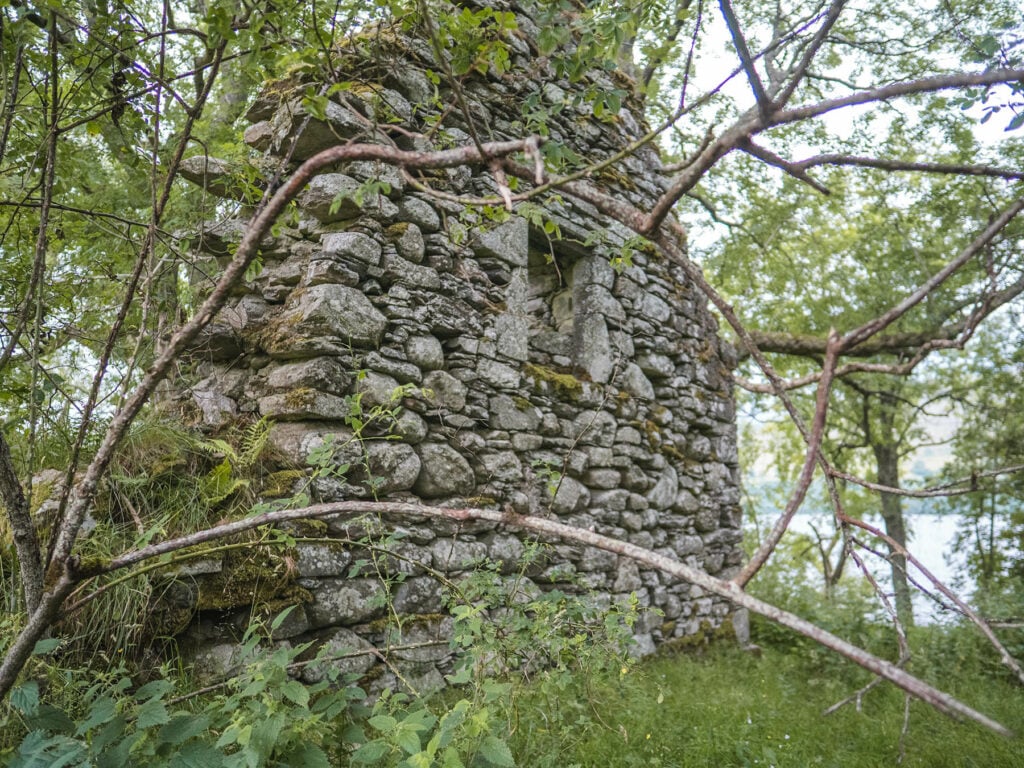
Lawers became part of the Breadalbane Estate in 1693
Due to growing financial issues which seemed to begin after the castle was burned down, the seventh Laird of Lawers, James Cambell sold the lands to the First Earl of Breadalbane which brought the Village of Lawers into the Breadalbane Estate.
Two Flax Mills were Built in the Mid 18th Century.
Lawers and the surrounding area reached a peak of activity and population between 1710 and 1840 during which time two flax mills were built in the Old Village of Lawers.
The Decline of Lawers between 1841 – 1926
Due to the increase in sheep farming and the removal of smaller farmers in favour of larger farmstead which was more profitable for the Breadalbane Estate, less villagers were required and the population gradually declined.
By the time of the 1841 census just 17 people were recorded as living in The Village Of Lawers, crammed into just a few houses. The Scottish Clearances meant there were not enough people left to support a Ferryman at Lawers..
By 1691 the population of Lawers was just seven. The last remaining inhabitants occupied the Pier House until 1926.
The Historic Scotland Preservation order was applied in 1995.
More information can be found on the Ancient Moments website and by reading Mark Bridgeham’s book on the village.
Planning your Visit to the Old Village of Lawers
The Old Village of Lawers is not signposted and I found it quite challenging to find. I also missed out on seeing the second half of the village on my first trip as it’s separated from the first part.
Below I’ve provided detailed guidance to help you avoid the mistakes I made and plan your perfect trip to the old village.
Is There Parking at The Old Village of Lawers?
There is a privately owned car park called Walkers Car Park shown on my map below. The car park is a few minutes walk from the Ben Lawers Hotel. Payment of £5 for a day’s parking is made by putting coins or notes into a small honesty box in the carpark. No overnight parking allowed.
You might also be able to park at Ben Lawers Hotel for free if you choose to eat or stay over at the hotel.
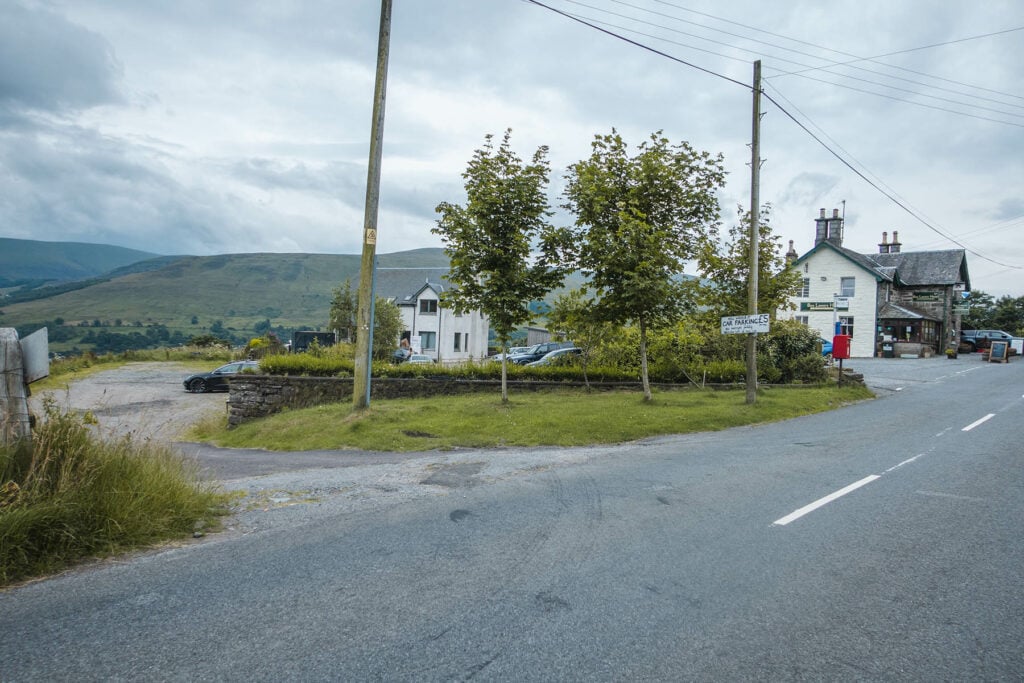
Opening Times
The village is open 24/7. However, with at least one ghost, overgrowth and fallen stones, visiting after dark is not for the faint hearted.
Is The Old Village of Lawers Free?
Yes, the Old Visit Of Lawers is free to visit. As a scheduled ancient monument there are certain restrictions which you can read more about here. I’ve included a quick summary below:
Vistor Guidance
- The use of metal detectors is prohibited
- Don’t photograph or film for commercial purposes without permission
- No camping
- No fires or bbqs
- No fishing or water-sports
- No alcohol on the site
- Do not take away stones etc. as souvenirs
- The path to the village is not suitable for motor vehicles
- Please take any litter home
What is the Best Time of Year to Visit?
Spring or summer. Avoid periods of heavy rain when the village may be muddy and more hazardous.
What is the Best Time of Day to Visit?
Anytime in daylight hours. Apparently some people choose to visit after dark to experience the supernatural elements of the village such as the ghost of the Lady of Lawers, although I’d not recommend this myself.
The Old Village of Lawers Weather
Like most of the United Kingdom, you are likely to find the best weather in the summer months: June, July and August. May and September can also be pleasant and may be slightly quieter.
This is a general rule of thumb as it is worth noting that it can rain at any time of year. The Old Village of Lawers walk is best avoided after heavy rainfall as the route will be muddy and slippery.
You can check weather for the local area on the met office and also the BBC website.
The Old Village of Lawers Walk
Below I’ve detailed the circular walk to the car park to the Old Village of Lawers including the buildings, pier and graveyard. This can be easily extended to take in more of the local area if required.

Route Overview
Walk Distance: 1.6 miles (2.6 km)
Walk Time: 1 hour
Walk Difficulty: Moderate
Path Quality: Poor (within the village)
Walk Description: From The Walkers Car Park, you head down Lawers Pier Road to the old Lawers Village and onwards to the remains of the Pier. From there you make your way through the first part of the village to the second part and over the bridge to the graveyard before looping back and retracing your steps back to Walkers Car Park.
Terrain Description: Wide dirt trails leading up the village and once in the village tall grasses and rocks to clamber over. Watch out for the tall nettles.
Download Maps: GPX | KML file for maps.me
Disclaimer: These GPS files are provided free-of-charge for personal use only and may not be uploaded elsewhere. By downloading you acknowledge that walking can be dangerous and this GPS data is provided without any warranty and you absolve this website for any liability.
Stage 1: Parking at Walkers Car Park and Walking to the Old Village of Lawers
There is no direct train or bus service operating in the area, making driving the best option to reach the start of the walk. Set your Sat Nav for Ben Lawers hotel Post Code: PH15 2PA.
Walkers Car Park carpark is a gravelled area 5-10 metres to the left of Ben Lawers Hotel. There is a small sign at the entrance to the car park.
After depositing your parking payment into the honesty box, take a right out of the car park onto the main road (walking away from Ben Lawers Hotel).
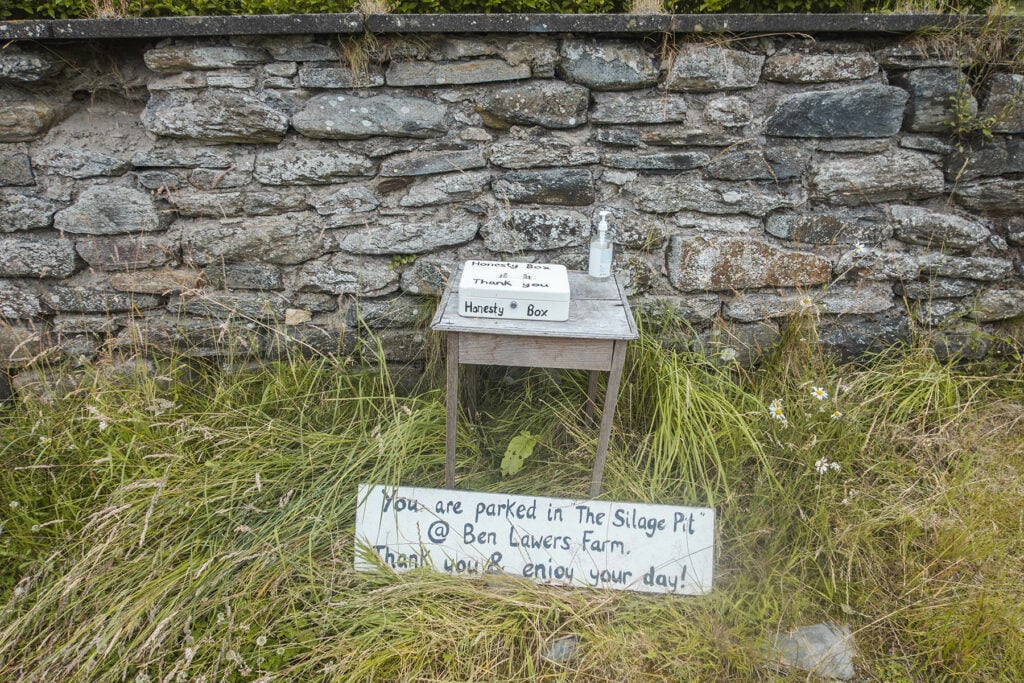
On foot, take the almost immediate right down the concrete path. Do not attempt to drive down this track as it is unsuitable for motor vehicles.
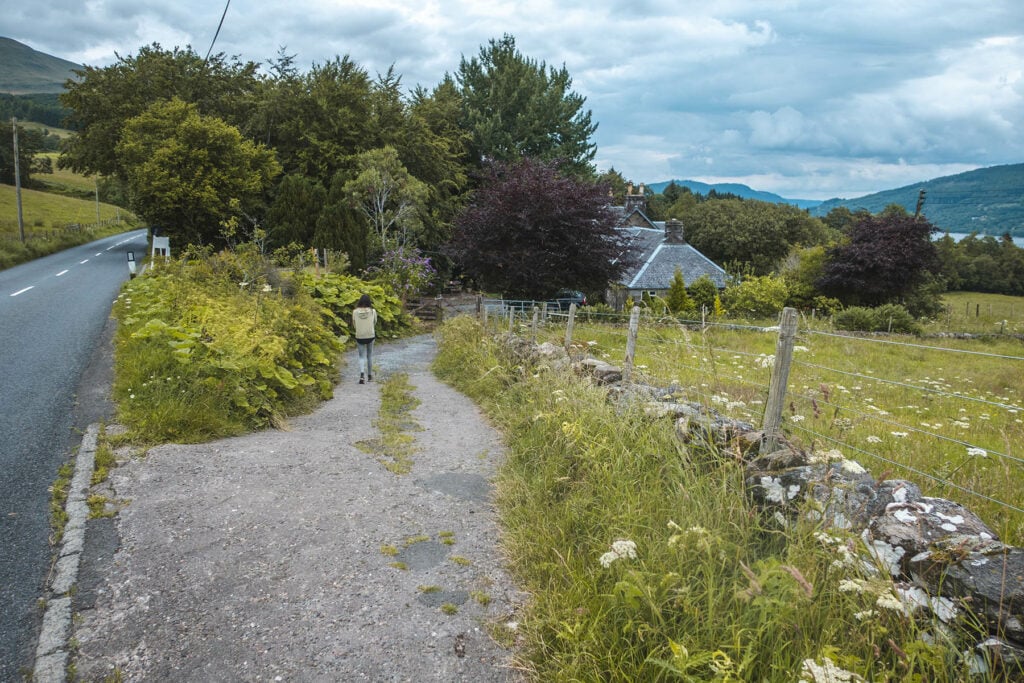
Continue down the path for around 15 minutes until you reach the gate to The Old Village of Lawers. Enter through the gate in front of you.
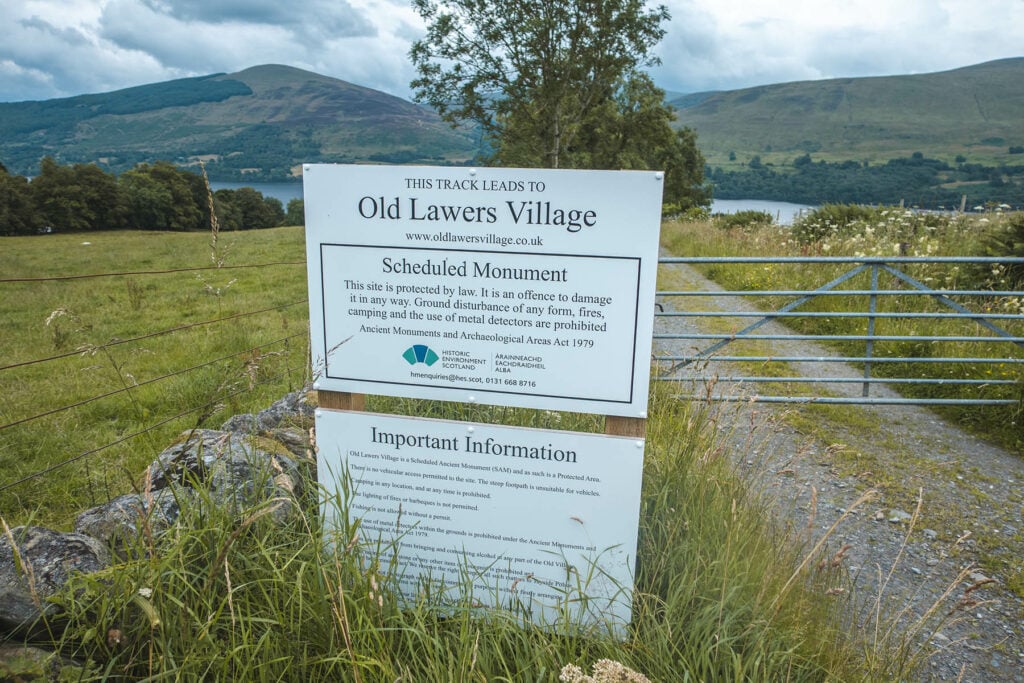
Stage 2: Exploring the Old Village of Lawers
As you enter the village, to your right are the remains of the Ferry Man’s Cottage (Pier House) and Lawers Pier. To your left are the remains of the Lady of Lawers’ House, another cottage and the church.
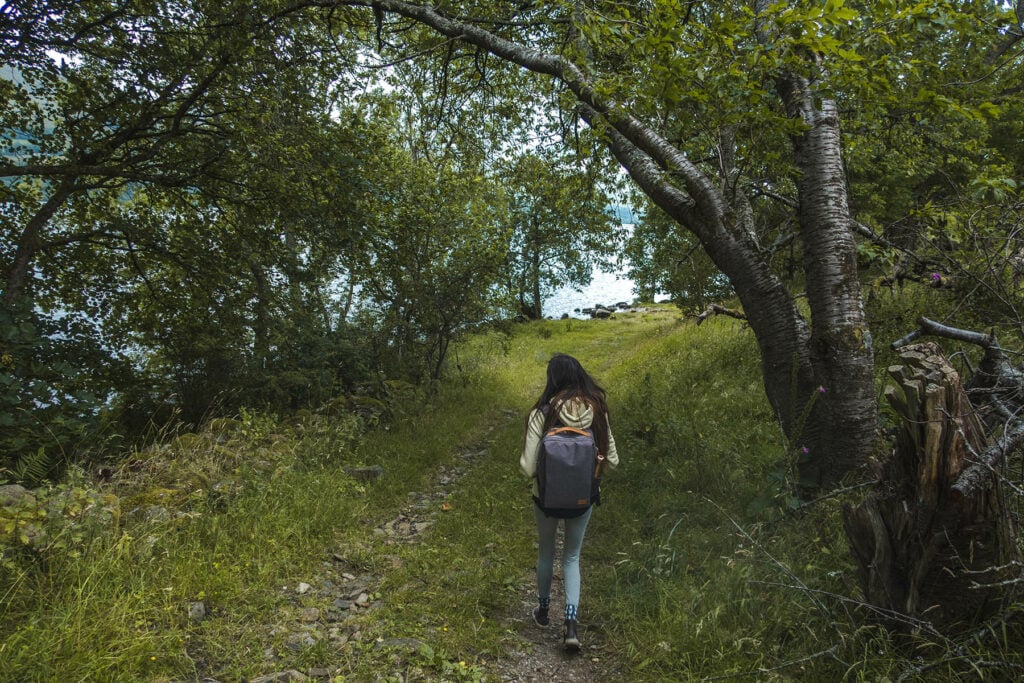
Take care exploring the remains as there are a large number of fallen rocks and heavy undergrowth including nettles.
Make your way over to the right towards the pebble beach and loch Tay. You can see the remains of the Lawers Pier and the abandoned Ferry Man’s Cottage (Pier House).
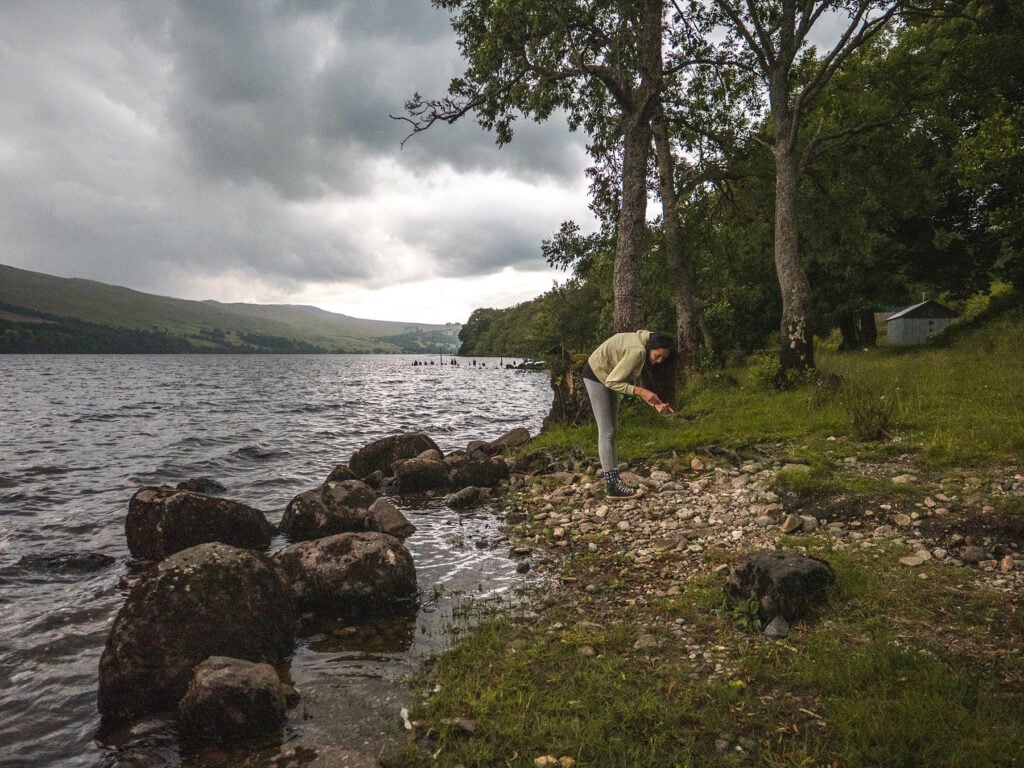
Retrace your steps to the gate and make your way through the village. You can see the Lady Of Lawers’ House (Laird’s House) followed by the Church (Kirk).
From the church, head up and to your right (east) through a gate into an open field. This used to be a cobbled street linking the two parts of the village. After 90m you will reach the second part of the village. There are remains of cottages, a lime kiln.
I didn’t know about the existence of the second part of the village on my first trip and only found out about it during my research afterwards. You’ll have to excuse my lack of photos – I’ll add these when I visit next time.
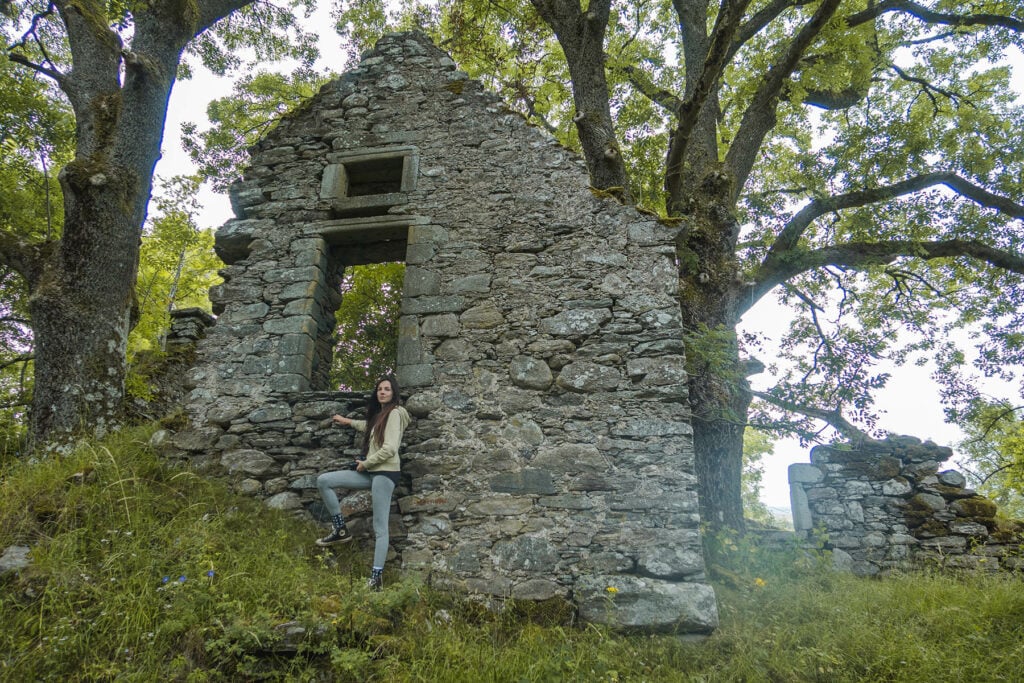
As you walk through the second part of the village in a northward direction you will see a bridge over Lawers Burn (fast flowing steam).
Slightly to your right alongside Loch Tay you can see the well maintained Cladh Machuim Graveyard, which is still in use today.
Retrace your steps back through both parts of the Lawers to the entrance gate to the village and back up the path back to the car park.
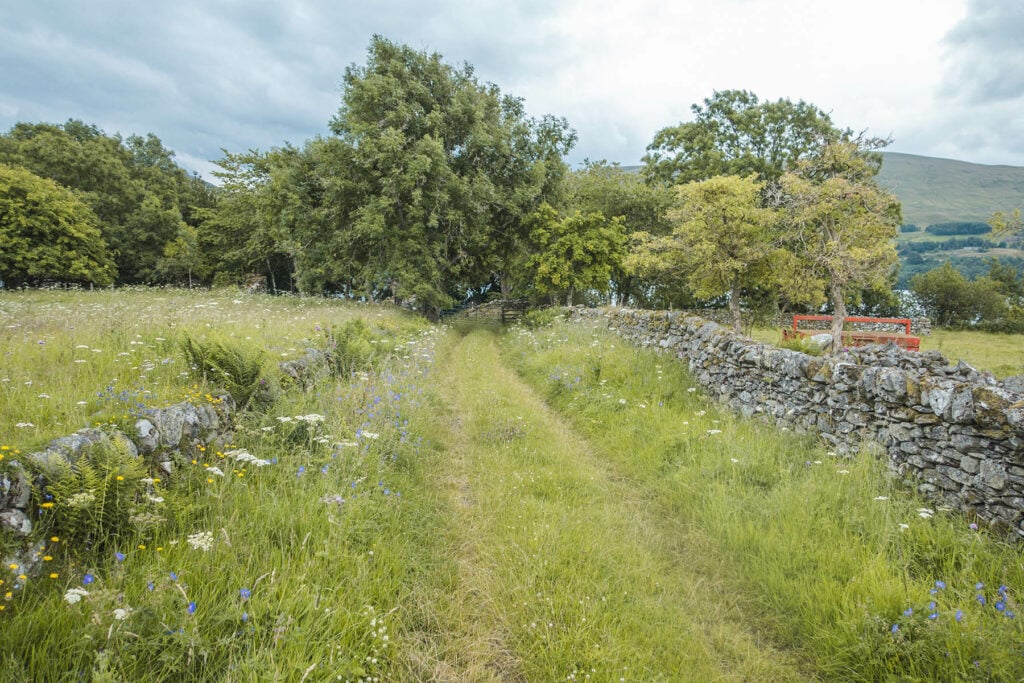
Where to Stay Near The Old Village of Lawers
The Old Village of Lawers is a short drive from one of Scotland’s most beautiful villages – Kenmore. Below are my top recommendations for where to stay in Kenmore.
The Mains of Taymouth Country Estate is my favourite place to stay in Kenmore. The estate includes a number of different properties including the Mains of Taymouth Houses (my personal favourites), the Gallops Apartments and the Maxwell Villas.
Final Thoughts on The Old Village of Lawers
The Old Village of Lawers is a true hidden gem in Scotland. It’s hard to find unless you know where you’re going, making it all the more exciting when you finally arrive. Due to its remote location, it’s untouched by modern life, allowing you to really step back in time and imagine life almost a thousand years ago on the shores of Loch Tay.
The stories and mystery surrounding the village and its inhabitants only add to experience. I’ve learnt a lot more about the village since my first trip and I look forward to visiting again on my next trip to Perthshire.
Ellamckendrick.com is a free online resource. If you have found this website useful for planning your adventures, you can show your support by buying me a coffee. Thanks so much!

Read More Perthshire Guides
Birks of Aberfeldy & the Falls of Moness: A Visitors Guide
Falls of Acharn and the Hermit’s Cave: The Ultimate Guide
Falls of Bruar: A Walker’s Guide
The Best of Loch Tay: 6 Activities You Won’t Want To Miss!
Tay Forest Park: A Complete Visitor’s Guide
Pitlochry Dam & Fish Ladder: Everything You Need to Know
Castle Menzies: A Complete Room By Room Tour

What a thorough description of this area! Thank you so much!
I was one of the people who was so very interested in purchasing the land; but missed out. I’m happy for the Donnelly family. I am sure they will watch over the land that captured my heart and soul.
Thanks for including a reference and link to my book. There will be an updated and enhanced version of the book available soon
I really loved reading your book and am excited that an updated version is coming soon 🙂